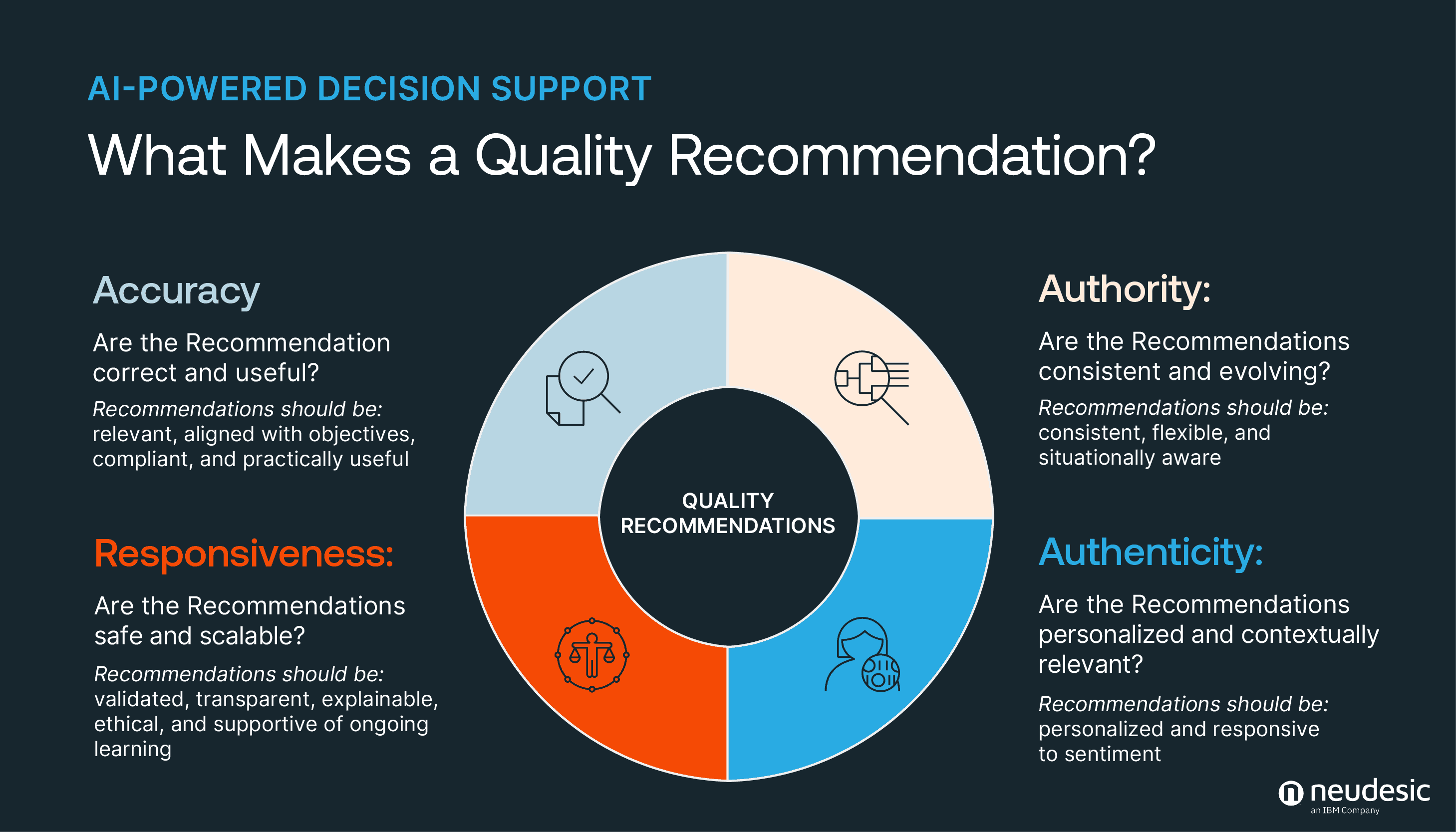
Key Takeaways:
- Role of AI-driven applications: Intelligent Applications (IA) enable informed decision-making by integrating a disparate knowledge base and feedback loops, creating new predictive insights and recommending workflows to enhance both internal operations and customer-facing personalized decision-making.
- Future standards: IA enables trustworthy, personalized recommendations at scale.
- Use cases: IAs offer a wide array of use cases across industries, including retail / ecommerce, customer service, healthcare, and media.
- Key considerations: IT departments can build IA that deliver trustworthy recommendations by understanding the components of quality recommendations and their implications for IT planning.
AI-driven decision-making is becoming mainstream in both internal operations and customer interactions. Examples include:
- Amazon: Utilizes context-aware user and search parameters (e.g., seasonality or historical purchases)
- Customer service: Supports representatives by leveraging customer insights to recommend solutions, boosting customer satisfaction
- Security and environmental management technology: Leverages multimodal data to drive automated decision-making or prompt the account owner
- Medical knowledge: Providers like IBM Watson Health provide patient-specific recommendations with clear traceability back to sources
- Streaming services: Prioritize media content based on prior viewing patterns
With each accurate recommendation, both enterprise users and customers gain confidence that future suggestions will also be trustworthy.
How does an enterprise create quality recommendations at scale to begin with?
To start, we need to understand what makes a quality recommendation. In this blog, we explore the components of a quality recommendation, and how Intelligent Applications leverages cross-ecosystem predictive insights to deliver personalized recommendations, enable decision adaptability based on feedback loops, and use self-learning mechanisms to continuously improve quality of recommendations.
How effective are your current enterprise recommendations?
Today, many organizations adopt a web of recommendation solutions that remain siloed across applications and data sets. This fragmentation leads to missed opportunities for insights and challenges in prioritizing recommendations at decision points. These recommendations often lack personalization and adaptability to real-time user feedback.
In other words, current recommendations are not adaptive to individual circumstances and fall short of users’ rising expectations from user experiences.
For example, consider a financial services firm facing consistent regulatory updates to their products and services across multiple consumer touchpoints. A combination of manual efforts and coordinated responses across platforms will be required to deliver consistent updates across knowledge portals, customer engagement chat, and customer service support. With IA, a cohesive response ecosystem is more seamless, enabling comprehensive knowledge updates across the organization.
Comparison: Fragmented Insight Mechanisms vs. Intelligent Application Recommendations
Limited Insight Recommendation Mechanisms:
- Siloed data sources resulting in basic or incomplete recommendation options
- Unclear prioritization and sequence of recommendations
- Low adaptability to changing user preferences or contexts; high dependency on past user behavior
- Poor or non-existent user feedback loop; requires manual intervention to adapt recommendations
Intelligent Application Recommendations:
- Cross-ecosystem data integration for a robust understanding of end-user objectives and intent (consumer or employee)
- Clear prioritization of recommendations based on understanding user objectives and intent across user and similar-user feedback loops
- Real-time adaptation to user behavior, sentiment and contextual factors
- Validation and cross-ecosystem redeployment of feedback loop data
What Makes a Quality Recommendation?
Trust and quality in IA recommendations mirror the fundamentals of person-to-person trust: accuracy, authority, authenticity, and responsiveness. Each of these factors comes with unique considerations for IA planning:
Accuracy: Are the Recommendations correct and useful?
Recommendations should be:
- Relevant: Correct interpretation and application of multimodal data
- Objective-aligned: Responses aligned to propel workforce or customer interaction towards desired business outcomes
- Compliant: Cohesive ecosystem updates for regulatory and internal guideline changes
- Of practical use: Predictive data integration across logistics, skillsets, required assets, and practical realities
Authority: Are the Recommendations consistent and evolving?
Recommendations should be:
- Consistent: Consistent intent and guidance in recommendations across the user base and similar scenarios
- Flexible: Integrate feedback loops and algorithm applicability testing to ensure user profile updates are integrated into evolving recommendations
- Situationally aware: Maintain consistency in messaging and actions. For example, avoidance of safety close-out prompts while a vehicle is in motion.
Authentic: Are the Recommendations personalized and contextually relevant?
Recommendations should be:
- Personalized: A balanced mix of standardized yet adaptable recommendations. For example, a maintenance worker should follow a standardized set of safety protocols, but is able to guide the IA toward the optimal repair path in particular conditions
- Demonstrative of sentiment understanding and response: Adjust responses based on sentiment, fatigue, or risk elevation.
Responsive: Are the Recommendations safe and scalable?
Recommendations should be:
- Validated: Usability validation across data, IT ecosystem, and user base without crossing privacy boundaries
- Transparent, explainable and ethical: Traceable recommendations and integration of Responsible AI principles and regulations
- Offer user control: Correct, adjust, and/or eliminate recommendations to mitigate harmful, irrelevant, inaccurate, outdated, non-useful, or non-personalized content
Support ongoing learning: Replicate best practice efficiencies across user and data interactions, including transfer of knowledge across other dimensions of decision-making
With key trust factors supported across the IT ecosystem, IA can now enable enterprise decision-making with personalization at scale, system adaptability to feedback loops, and ongoing recommendation improvement mechanisms. Below are a few use cases for each type of impact.
Enhanced Recommendations Use Cases
A Retailer Uses Personalization at Scale:
Traditional customer insights might recommend outdoor activity trackers based on similar purchases across a user group. However, they might not consider the user’s recent move to a different geographic climate, recent queries about indoor sportswear, and a 2-year cycle on outfit refreshes.
By understanding and applying pattern recognition, prioritization, and evolving scenarios, IA can deliver more customized customer engagements that considers current trends, user behavior in real-time, and external factors like seasonality or cyclical purchasing.
An Energy Firm Delivers System Adaptability to Real-Time Events:
A traditional solution for a weather-related incident response would require employees to navigate various field applications, mobile communication channels, and internal sites to gather necessary information. The fragmented experience, delayed information gathering, and unclear prioritization of response activities creates inefficiencies in response, posing potential risks to worker safety.
Alternatively, with IA, the resolution team accesses one web-based intelligent application as a central command center for response. Sensing the outages, the IA sorts the user interface autonomously-prioritizing critical outage, safety, and repair information- and recommends tasks based on the user’s location, skill sets, and available inventory in the employee’s truck.
A Medical Monitoring Firm Leverages Feedback for Ongoing Recommendation Improvement:
Traditional machine learning (ML) may identify connections between inactivity and heart rate, providing activity reminder prompts, but fails to easily integrate feedback from a user with a strained back who seeks activities to maintain fitness while recovering. If responses don’t align to their current scenario, the user is more likely to abandon remote monitoring usage altogether.
Alternatively, IA can provide recommendations based on unseen user adoption and usage patterns, fill in probable data gaps, and mitigate irrelevant messaging.
These are just a few examples of IA’s potential to leverage context and feedback to provide elevated engagement and superior recommendations.
Conclusion
Intelligent Applications provide a pathway for superior enterprise outcomes in AI-driven recommendations for both workforce and customer engagement. The status quo of fractured and uncoordinated insights is no longer sustainable, as non-personalized experiences fail to meet advancing user expectations and business needs
With a robust IA strategy for delivering confident recommendations, businesses can look forward to personalized recommendations at scale, system adaptability to user feedback, and ongoing recommendation improvement mechanisms. The process of creating quality recommendations at scale begins with understanding the technology ecosystem and its implications for accuracy, authority, authenticity and responsiveness. Establishing this foundation enables enterprises to begin on their IA journey with strong content governance-an essential factor for managing predictive insights and user feedback effectively.
Related Posts
